The Bernini's Last Wish
Rome, Italy
Gian Lorenzo Bernini (Naples 1598 – Rome 1680), an architect, sculptor, painter, set designer, and playwright, was the foremost artistic personality of the Italian Baroque. His works are on view for all to see: they can be admired in the most beautiful piazzas, palaces, and churches of Rome; the city that embraced his genius until his death.
He passed away peacefully at the age of eighty-two, to the universal mourning of the Romans who were losing their illustrious fellow citizen. According to some, at the first light of dawn, an endless funeral procession accompanied his coffin, while according to the sacristan of Santa Maria Maggiore, it was conducted from the Parish of S. Andrea delle Fratte to the Basilica at two in the morning. The following morning, the artist's body was displayed in the middle of the church, nobly adorned and illuminated with 60 torches; a choral Mass was sung, and bread was given to the poor.
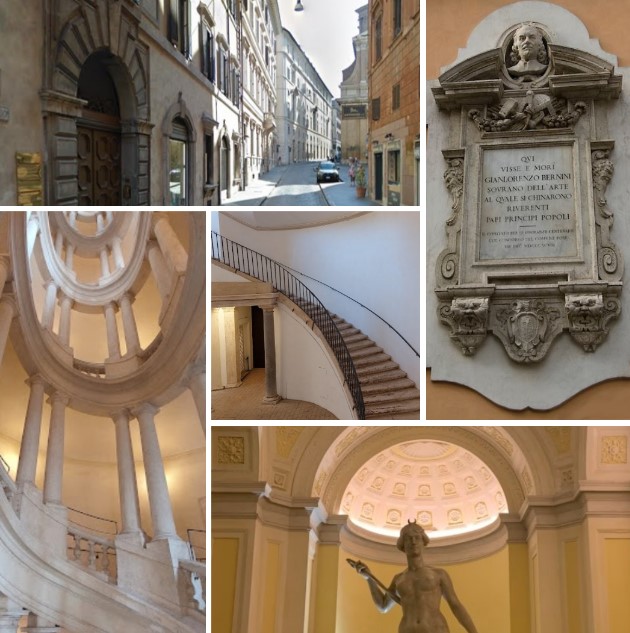
Photo of the Bernini Palace and its interior at Via Mercede 11 (with the church of S. Andrea delle Fratte visible in the background), and a late 19th-century commemorative plaque at number 12A.
The choice to celebrate his funeral in this basilica was not random, as he had lived opposite it for many years after moving from Naples to Rome with his father at the age of eight. The area was out of the way at the time, partly used as vineyards and frequented mostly by pilgrims. But in 1642, just over forty years old, having become famous and wealthy, he was able to move to a more central area. He purchased a palace at Via della Mercede 11 in Rome, opposite the Parish of S. Andrea delle Fratte in the Colonna district. Here, Bernini had his studio on the ground floor and his residence on the upper floors. It was in this house that he died.
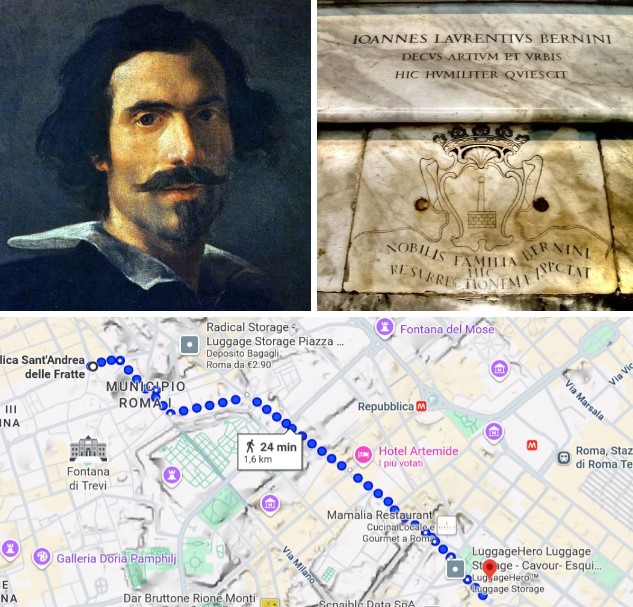
Portrait of Gian Lorenzo Bernini, the family tomb inside the Basilica of Santa Maria Maggiore, and the plaque.
The remains of the great artist were displayed in a packed Santa Maria Maggiore and then enclosed in the family tomb, prepared many years earlier by himself, in the right lateral nave, to the left of the tribune. A small plaque is set into the floor, engraved with the Bernini coat of arms and a scroll underneath with the inscription:
NOBILIS FAMILIA BERNINI HIC RESURRECTIONEM EXPECTAT
This noble Bernini family here awaits the resurrection
This simple Latin epitaph expresses the hope of resurrection for Gian Lorenzo and his father Pietro, who had their workshop behind the Pauline Chapel of the Basilica of Santa Maria Maggiore, on Via Liberiana.
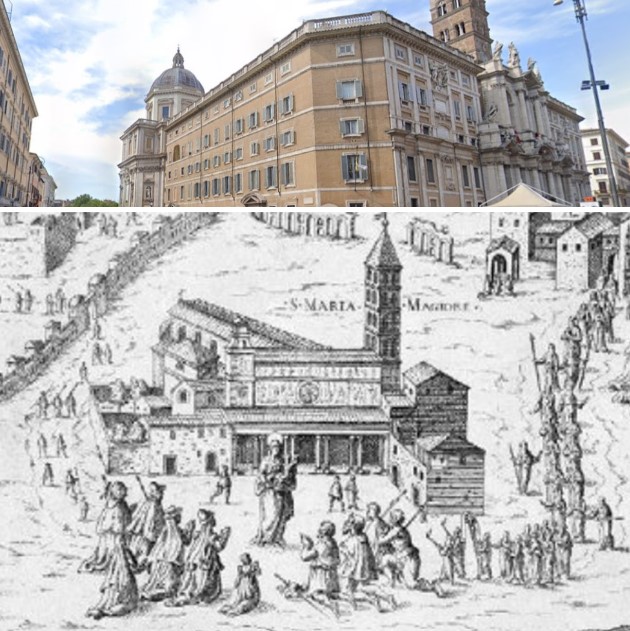
View of Santa Maria Maggiore in the 17th century, and today (left: Via Liberiana with a view of the Pauline Chapel; right: the piazza with the entrance to the basilica).
To Bernini, who inspired so much admiration in illustrious persons and Romans, the Eternal City at that time paid no formal tribute. There was no street named after him, only a small alley near Piazza San Silvestro called 'del Bernini', but even that has disappeared today.
On the house near Piazza Santo Andrea delle Fratte, a modest plaque with this inscription was mounted in 1898:
HERE LIVED AND DIED
GIAN LORENZO BERNINI
BEFORE WHOM BOWED REVERENTLY
POPES, PRINCES, AND PEOPLES
Upon his death, Bernini left annual donations to a poor and good spinster chosen at random; to his domestic collaborators; to some nuns, including a niece of his; to a nephew who was a priest and who assisted him on his deathbed; to the church of Santi Quattro (where the sculptors' guild was based) so that a Mass would be celebrated each year for all the deceased members of his family; a small amount of money to his daughters because they had already received a generous inheritance from their mother; to his brother Luigi, the portrait of the King of England executed by Van Dyck; while to his old friend and son-in-law Antonio di Filippo, a painting of his choice from among the many in the house; all the rest (movable and immovable property, gold and silver coins), after deducting debts and legal expenses, to his son Paolo (the second-born son invested with the rights of primogeniture) and in case there were no male descendants, it was to pass to the third-born son Francesco, then to Domenico, provided the sons did not become priests, otherwise everything would go to the benefit of the spinsters identified by the institution of the Santissima Annunziata.
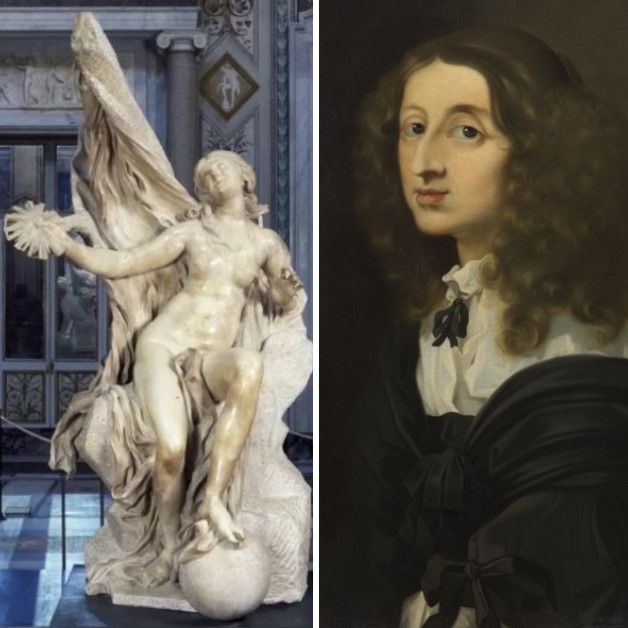
Sébastien Bourdon, Portrait of Christina of Sweden, 1652-1657, Stockholm, National Museum and, Truth Unveiled by Time (1645-52) by Gian Lorenzo Bernini, Galleria Borghese, Rome. The young girl, seated on a rocky mass, holds the sun in her right hand and rests her left leg on the terrestrial globe, according to an iconography already canonized in the famous Iconologia by Cesare Ripa (1600)
In addition to all this, Bernini left 400,000 scudi to his great friend Queen Christina of Sweden (1626-1689). At that time, she resided in Rome, and when the prelate went to give her the news, she replied: If he had served me, I would be ashamed that he had left so little.
Evidently, this sum seemed like a trifle to her. What she truly appreciated was the statue of 'Truth Unveiled by Time' made by Bernini, which was located in the artist's home studio. The queen often went to observe and praise it. One day a Cardinal said to her: — Your Majesty is the first among crowned heads who likes the truth.” She replied: “But not all truths are made of marble.
Bernini executed the work between 1645 and 1652, during a difficult period in his career, coinciding with the election to the papal throne of Innocent X Pamphili (1644-1655), who preferred the architect Francesco Borromini (1599-1667) to him. The artist intended to show Truth represented allegorically as a naked young woman having her veils removed by the figure of Time above her, but this second allegory was never executed. Bernini had expressed his intention to add the figure in 1665, but he ultimately never completed the work.
In his will, Bernini left the sculpture in perpetuity to the firstborn of his family, although Cardinal Mazarin had wanted to buy it.
From Bernini's studio on Via della Mercede; in 1852 it was transferred to the palace of his descendants on Via del Corso, where it was displayed on an inclined stucco block. It remained there until 1924, then passed to the Galleria Borghese, and in 1956 was purchased permanently by the Italian State.
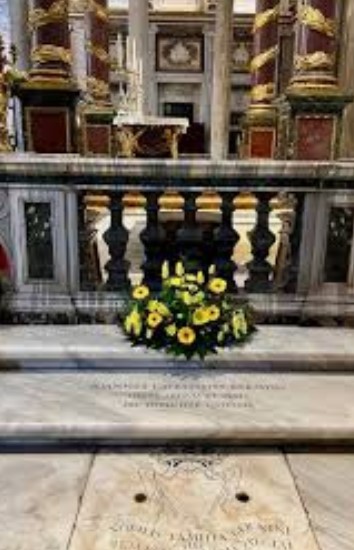
Bernini's tomb
Basilica Santa Maria Maggiore, Piazza di Santa Maria Maggiore, (Rome)
